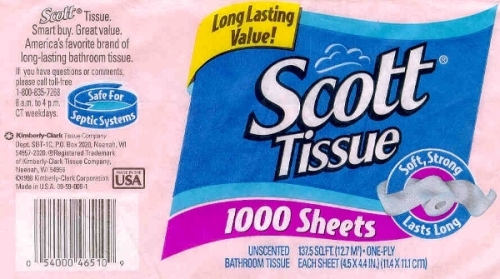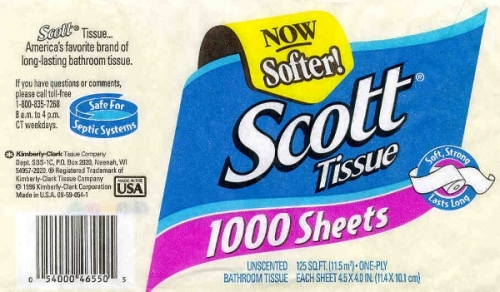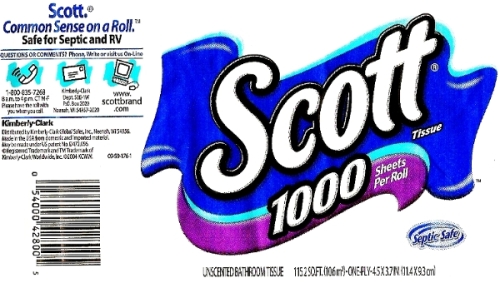This is the first installment of what will be a continuing category of articles from RoutingByRumor. We will be documenting the most egregious examples of popular consumer products that are shrinking, being downsized or otherwise reduced in quantity or quality by manufacturers often employing “deception engineering” in an attempt to hide the changes from consumers.
Shrinking Product # 1 – Scott Toilet Tissue
Perhaps the most visible and distressing shrinking product category is paper products. Paper manufacturing requires large amounts of energy and water, and transportation costs represent a larger portion of the finished product’s price than most products. Because of their weight and bulk, paper products are particularly vulnerable to increased energy, transportation and raw materials costs.
The result has been ever decreasing quality and quantity of tissues, toilet paper and paper towels, to name just a few paper products. One of the largest manufacturers, Scott / Kimberly-Clark of Neenah, Wisconsin, has responded by a series of price increases and successive product downsizing.
Focusing on one Scott product, toilet tissue, we will examine some of the tactics Scott has employed in am attempt to camouflage the fact that you are paying much more for much less. One of Scott’s flagship products is the 1000-sheet roll of tiolet tissue. In the last few years, the retail price of a 1000 sheet roll of Scott toilet paper has roughly doubled, from about 45 cents (US) to about 90 cents. But the price increase only tells part of the story.
While Scott still advertises (in my opinion, deceptively) that it still contains 1000 sheets per roll, a roll of Scott tissue is substantially narrower and shorter than it was a few years ago. Since I started keeping track, the size of each individual sheet has gone from 4.5 x 4.4 inches (19.8 square inches), to 4.5 x 3.7 inches (16.65 square inches). Each time Kimberly-Clark has downsized the roll of ScottTissue, it has shrunk by almost ten percent. While I am not absolutely certain about this, I believe that if you go even further back in time, the standard toilet paper roll was 5 inches wide. I believe the tissue is substantially thinner, and in my opinion, much lower quality than it was previously. Another attempt to hide the reduction in quantity is to wind the roll on a much larger diameter paper tube, and to emboss the tissue, adding bulk without adding paper, so the outside circumference of the roll appears larger. Another indication of the decreasing amount of tissue on each roll is weight. Pick up a 6-pack or 12-pack of toilet paper these days, and it feels like it weighs perhaps half as much as it did a few years ago (some other brands are even worse).
In my opinion, the most insidious part of this is not that you are paying more per roll. It’s that because you are getting less in each roll, they are forcing you to buy more and more rolls (assuming that your consumption remains constant). It’s like the oil companies figuring out how to produce gasoline that provides lower and lower miles-per-gallon, forcing you to fill up more often, on top of the fact that the price-per-gallon keeps going up! Reducing a product’s size or yield masks the true extent of a price increase.
You are paying about double, but qetting 15-20% less than you did a few years ago, of a product I believe is substantially lower in quality. While Scott does not disclose the percentage of recycled fibers in their toilet tissue (or in any of their other products, to my knowledge), I have to believe their toilet paper is either made from 100% recycled paper, or it is made from predominately recycled fibers. I base this conclusion partly on the fact that when it comes in contact with water, it disintegrates instantly. I believe that is an indication that the length of the cellulose fibers is extremely short, and indicative of recycled fibers.
Of course, the proof is in the pudding, as the saying goes. Without getting too graphic, I believe the efficacy of Scott toilet tissue has decreased substantially as a result of Scott’s tinkering with the recipe, if you will. Certainly, there is a lower limit, at which a product’s size, quality and value will drive consumers to choose a competing product. My guess is that for some consumers, that limit has already been reached by Scott / Kimberly-Clark. I guess manufacturers try to find out what that limit is, without exceeding it.
Here’s some photos of the “Incredible Shrinking Roll” of ScottTissue.
(Note that the most recent wrapper below no longer unequivocally says “Made In USA”, but rather states “Made in USA of domestic and imported materials”, and fails to provide further details as to what percentage of the product is domestically sourced.)

1000 sheets @ 4.5″ x 4.4″ = 137.5 square feet

1000 sheets @ 4.5″ x 4.0″ = 125 square feet

1000 sheets @ 4.5″ x 3.7″ = 115.2 square feet
LATE BREAKING NEWS…
Dateline: June 8, 2008
CVS Stores has just beaten Scott Paper in the race to create the world’s smallest roll of toilet paper. Read all about it here.
– Routing By Rumor
















